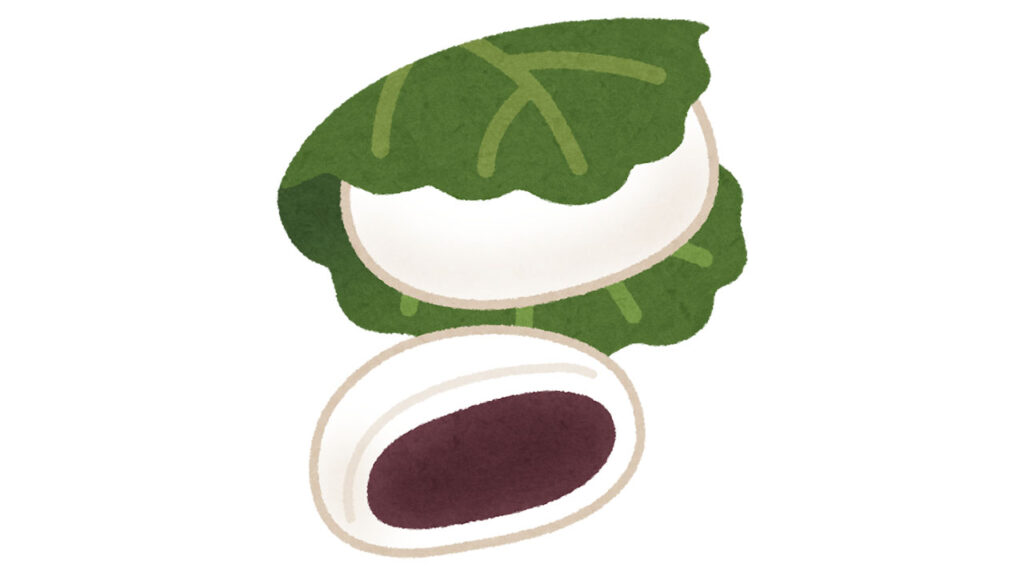As spring blooms across Japan, so too do seasonal traditions that have been passed down for generations. Among them is Kashiwa Mochi (柏餅) — a simple yet deeply symbolic Japanese sweet that perfectly embodies the harmony of nature, family, and seasonal celebration.
To foreign visitors, it may appear to be just a rice cake wrapped in a leaf. But beneath its modest appearance lies centuries of meaning, ritual, and cultural depth.
What Is Kashiwa Mochi?
Kashiwa Mochi is a traditional Japanese confection consisting of:
- A soft, chewy mochi (glutinous rice cake) made from steamed and pounded sticky rice.
- A sweet filling, typically anko (sweet red bean paste) or occasionally white miso-based fillings.
- The entire cake is wrapped in a large, aromatic oak leaf (kashiwa no ha).
The oak leaf is not meant to be eaten but serves both a symbolic and functional purpose. When unwrapped, the sweet fragrance of the leaf blends subtly into the mochi, enhancing its flavor.
The Symbolism of the Oak Leaf: More Than Just Decoration
At the heart of Kashiwa Mochi’s cultural meaning is the oak leaf itself:
- Kashiwa (oak) trees in Japan are evergreens whose old leaves don’t fall off until new buds emerge.
- This characteristic came to symbolize generational continuity — the idea that family lines will continue without interruption as one generation gives way to the next.
- Thus, Kashiwa Mochi became a good-luck charm for family prosperity, fertility, and healthy children.
The very act of eating Kashiwa Mochi is a way of expressing hopes for lineage, growth, and the well-being of future generations.
The Seasonal Connection: Kashiwa Mochi and Children’s Day
Kashiwa Mochi is most famously associated with Children’s Day (Kodomo no Hi, May 5th) — one of Japan’s most important springtime celebrations:
- Originally part of Tango no Sekku, a festival for boys, it has since evolved into a national holiday celebrating the health and happiness of all children.
- Families display colorful koinobori (carp streamers) and samurai helmets, while enjoying traditional foods like Kashiwa Mochi.
- The symbolism of the oak leaf ties perfectly into this festival’s theme of family growth and future prosperity.
While available year-round in some regions, Kashiwa Mochi is primarily enjoyed during spring festivals and special family occasions.
How Kashiwa Mochi Is Enjoyed
Kashiwa Mochi’s flavor and texture offer a delicate balance:
- The chewy mochi provides a pleasantly elastic mouthfeel.
- The sweet bean paste filling adds richness without being overpowering.
- The fragrance of the oak leaf subtly infuses the mochi with an earthy, herbal note.
- Occasionally, some varieties use white miso filling, creating a more savory-sweet contrast.
Kashiwa Mochi is often paired with green tea, allowing the slight bitterness of the tea to complement the sweetness of the mochi.
The Practical Benefits of Oak Leaves
Historically, the use of oak leaves wasn’t just symbolic — it had practical benefits as well:
- Natural preservatives: Oak leaves contain tannins and polyphenols with antibacterial properties, helping preserve the freshness of the mochi.
- Moisture control: The leaf helps retain the rice cake’s softness while preventing excessive moisture buildup.
- Food safety: Before refrigeration, these properties helped extend the shelf life of delicate sweets.
Although these functional benefits were valuable in the past, today the leaf’s role is largely ceremonial, preserving the tradition.
Kashiwa Mochi and the Japanese Aesthetic of Seasonality
One of the most beautiful aspects of Japanese culture is its deep connection to the seasons, known as “shun” (旬) — enjoying foods at their peak moment. Kashiwa Mochi exemplifies this seasonal mindfulness:
- Its appearance signals the arrival of late spring.
- It becomes a sensory link between nature, family, and tradition.
- Eating Kashiwa Mochi during spring holidays connects modern life to centuries-old seasonal rhythms.
Summary
Kashiwa Mochi is far more than a seasonal sweet—it’s a culinary embodiment of Japan’s values surrounding family, prosperity, nature, and tradition. Through its use of the symbolic oak leaf, it weaves together practical food preservation, spiritual meaning, and seasonal celebration into one simple, elegant package.
The next time you unwrap a piece of Kashiwa Mochi, take a moment to reflect not only on its gentle flavor but also on the centuries of history, hope, and generational wishes tucked between the mochi and its oak leaf wrapper.


